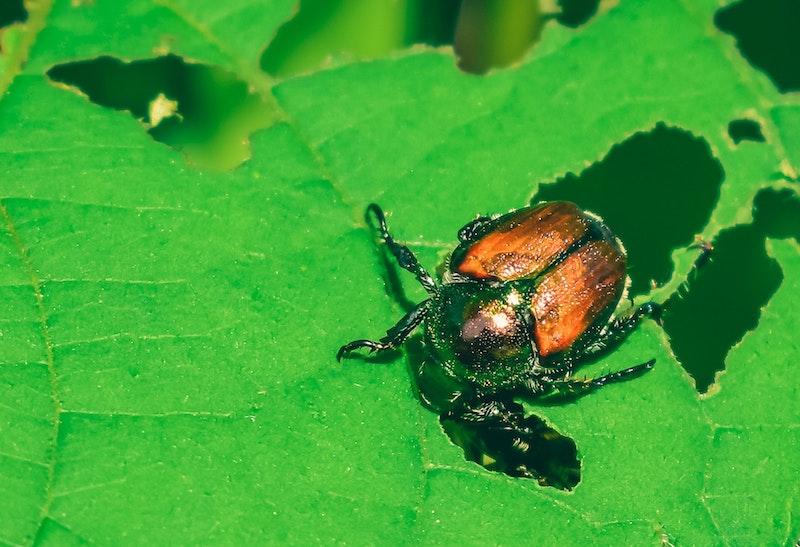Weigela is a flowering shrub that features lovely pink or lavender flowers. Blooms are heavy in the spring, and this pollinator-friendly plant continues to bloom into the summer. Unfortunately, weigela is not only popular with hummingbirds and butterflies, but several pests also like this perennial shrub. A pest infestation can damage the plant and impact growth and flowering. Weigela blooms on old and new wood so that a significant infestation can impact this year's and next year’s bloom cycle. Aphids, four-lined plant bugs, Japanese beetles, and mealybugs are some of the most common pests to impact weigela. Learn how to spot the signs and prevent pest damage on weigela.

Common Weigela Pests
Aphids
Aphids are tiny sap-sucking pests that drain the nutrients from the plant. Signs of an aphid infestation include yellow foliage, curled or twisted leaves, and stunted or dead growth. Aphids can kill vegetation, causing the plant to drop leaves. Leaf drop is unsightly, and the plant cannot conduct photosynthesis, which can impact growth.
Treating Aphids on Weigela
The most effective way to treat aphids on weigela is with insecticidal soap or horticultural oils. Treatment kills the pest, preventing further damage. Remove severely infested foliage and destroy the vegetation to prevent further spread. Apply fertilizer to encourage new growth to help the weigela recover.
Preventing Aphids on Weigela
Prevent infestations on weigela by proactively spraying any stray aphids with a stream of water. Spraying the aphids will knock them to the ground and drown them before they can cause severe damage. Avoid over-fertilizing the plant, which can increase the risk of an aphid infestation. Aphids prefer plants that have high nitrogen and new, supple growth. Plants fertilized more often than necessary attract aphids and recover more slowly.
Four-Lined Plant Bugs
Four-lined plant bugs are tiny insects identifiable by the four black lines along the length of their green or yellow bodies. These pests are sap-suckers, and by removing sap, they remove nutrients the weigela needs to grow and thrive. Damage from four-lined plant bugs includes sunken spots in leaves that appear black or brown. The recessed areas eventually give way to holes in the foliage. A severe four-lined plant bug infestation can cause leaf drop.

Photo by Christina Butler, cropped image, Flickr, Copyright CC BY 2.0
Treating Four-Lined Plant Bugs on Weigela
Insecticidal soap is effective at treating four-lined plant bugs. Adults are not impacted by insecticidal soap, but it effectively kills young pests, also known as nymphs. Continue to spray the plant for several weeks to ensure all of the eggs and immature four-lined plant bugs are eradicated. Remove damaged foliage, where the adults lay eggs, to prevent further spread. Burn the damaged foliage to kill the eggs.
Preventing Four-Lined Plant Bugs on Weigela
The best way to prevent four-lined plant bugs is to preemptively spray the plants with insecticidal soap early in the growing season. Insecticidal soap works very well at killing eggs and young pests in the larvae stage. Catching the infestation early is sometimes the closest you can get to prevention. Continue to spray the weigela throughout the season as a preventative measure in case any pests are present.
Japanese Beetles
Japanese beetles are hard-shelled pests that eat the foliage of plants like weigela. These pests are highly destructive and cause a lot of damage quickly. Japanese beetles eat holes in the leaves, creating a lace-like pattern. Damaged leaves are essentially useless and no longer support the plant. Japanese beetles have copper-colored wings with an almost iridescent shine. They have black bodies with white spots that are visible alongside their wings.

Treating Japanese Beetles on Weigela
The quickest way to treat Japanese beetles is to pick the pests off the plant as you see them. Crush the beetles to ensure they do not further damage the weigela or other plants. Spray the plant with a mixture of water and a couple of squirts of dish soap to discourage these pests from staying on the plant. You will need to re-apply the soapy mixture after rainfall or heavy dew.
Preventing Japanese Beetles on Weigela
Japanese beetles lay their eggs in the ground, and the larvae live there before emerging as adults. The larvae can cause damage to lawns and are a draw for moles and voles, so getting rid of the eggs and larvae is beneficial for more than just your perennial shrubs. Products like milky spore are effective at killing the larvae, which will mean none or few adult Japanese beetles.
Mealybugs
Mealybugs are sap-suckers that drain a plant of sap and the nutrients contained in the sap. Damaged foliage often dies and compromises new growth. Another sign of mealybugs is also their waste, known as honeydew. Mealybug waste attracts ants and other pests, which can cause more damage. These pests appear as brown spots on the foliage, and their egg sacs are white with a fuzzy texture.
Treating Mealybugs on Weigela
Treat mealybugs on weigela by spraying the plant with a hose to knock the bugs and their eggs from the plant. Continue to spray the plant with water to forcibly remove the mealybugs and follow up by spraying the weigela with insecticidal soap. Continue to treat the plant with insecticidal soap throughout the growing season to ensure any stray eggs or adult pests are taken care of.
Preventing Mealybugs on Weigela
Insecticidal soap or a mixture of water and dish soap sprayed on the weigela will help keep mealybugs away. Proactively spraying the shrub will ward off pests and kill eggs already on the plant, preventing significant damage.
Sources: "Weigela (Weigela)." Connecticut State - The Connecticut Agricultural Experiment Station. portal.ct.gov
 |
Author Alison Cotsonas - Published 07-06-2023 |
